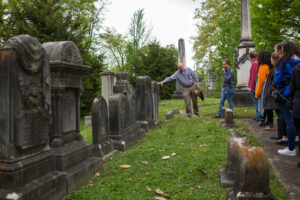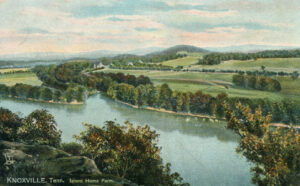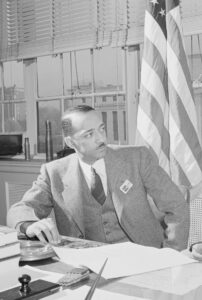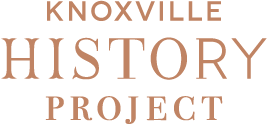Current Projects
Art Wraps
KHP Shoebox
Downloadable Walking and Driving Tours
Knoxville Chronicles: A New Podcast Series
Knoxville: A Walking Literary Guide

Jack Neely leads UT Public History students on a tour of Old Gray Cemetery (Photo by Prof. Pat Rutenberg.)
Annually, KHP serves more than 3,000 participants through 80 educational programs, both in-person and online. We continue to provide talks and guidebooks for Leadership Knoxville and Introduction Knoxville cohorts, Social Studies Teachers, UT public history students, and members of numerous other organizations and community groups.
We lead monthly tours of the Eugenia Williams House on Lyons View Pike and support local tourism through regular blog posts and consultancy services for Visit Knoxville. We are also a dependable source for local history information for local TV and radio stations who call on us almost weekly for help interpreting stories.
2023 Priorities
South Knoxville Community History:
 In 2023, KHP will undertake extensive research for a groundbreaking full-color community history book to be published in 2024. Given major developments along Sevier Avenue and Blount Avenue, coupled with the expansion of Ijams and the Urban Wilderness, a history of South Knoxville, the largest of the city’s sectors, is both timely and overdue.
In 2023, KHP will undertake extensive research for a groundbreaking full-color community history book to be published in 2024. Given major developments along Sevier Avenue and Blount Avenue, coupled with the expansion of Ijams and the Urban Wilderness, a history of South Knoxville, the largest of the city’s sectors, is both timely and overdue.
We’ll dig into the early years, the pioneers who settled across the river when the area was outside of city limits and known as “South America.”
The landscape changed dramatically over the decades, marked by Civil War Forts and later marble quarries, and lumber mills, and wealthy businessman Perez Dickinson’s progressive and expansive Island Home estate. By the 1890s, the construction of a new Gay Street bridge brought the streetcar, and then automobiles paved the way for suburban growth.
The 1920s saw the emergence of the East Tennessee bird sanctuary along the river surrounding the Ijams family home, which was also becoming a Girl Scout camp, and adjacent to it a new campus the Tennessee School for the Deaf and the downtown Island Home Airport.

William Hastie. (Library of Congress.)
By the 1930s, the movement to establish a new national park brought increasing numbers across another new bridge, the Henley Bridge, south to a new “Highway to the Smokies,” named after Col. David Chapman.
Existing buildings such as Kern’s Bakery, Young High School, and Candoro Marble, and Loghaven, all renovated and re-used throughout modern day South Knoxville, are all cultural icons and have stories to tell.
We’ll also look at interesting South Knoxvillians including William Hastie, a Woodlawn Pike resident who became the nation’s first African American federal judge in 1937, and later territorial governor of the U.S. Virgin Islands; German immigrant and Bauhaus alumnus Alfred Clauss, the architect who conceived an all-modernist community on Little Switzerland; investigative journalist Paul Y. Anderson (1893-1938), who grew up in the Island Home area, and earned the Pulitzer Prize for his exposure of the Teapot Dome Scandal; and author Cormac McCarthy, who spent his adolescent years on Martin Mill Pike.
Finally, we’ll round up histories from all major neighborhoods, historic churches, cemeteries, schools, businesses, and other notable sites across the landscape.
CORE PROGRAMS
Talks and Tours: KHP serves Knoxville residents and visitors through engaging educational programs, both in-person and online through Zoom. Our programs illuminate the city’s past, incorporating new research and previously untold stories covering a broad range of subjects, presented by KHP staff and guest presenters.
Research Projects: KHP works with individuals, developers, property owners, government departments, and community-based organizations to research and produce new narratives expanding awareness and a better understanding of the city’s complex past.
“The Scruffy Citizen:” Freshly researched articles highlight a diverse variety of relevant but little-known stories from Knoxville’s past, shared with KHP supporters and then posted online.
Knoxville History Online: KHP’s website offers a comprehensive online resource, including stories, historic sites, image galleries, videos, podcasts, maps, and our online store.
Knoxville Shoebox: We encourage community members to share photographs, brochures, and illustrations to be permanently archived for historical use.
Library Readership: To serve the general public, we produce hardback versions of KHP publications through the Knox County Public Library system.






